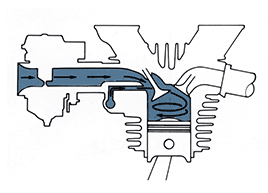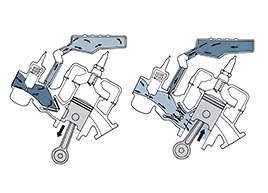Yamaha’s first 4-stroke engine motorcycle, the Yamaha XS1 (650 cc), was exhibited at the Tokyo Motor Show in 1969. People commented on its vivid green color and distinctive Yamaha light, sporty form, but the fact that “2-stroke Yamaha” had produced a 4-stroke, large-displacement motorcycle drew the most attention.
Large-displacement motorcycles at the time were referred to as “super bikes” or “super sports,” and their horsepower, top speed, and other performance characteristics graced the covers of motorcycle magazines nearly every month. The development project for the XS1, however, was intended to clearly differentiate it from other companies that emphasized raw power. Since motorcycles are operated by people, where the rider and the machine become one, the company chose to pursue distinctive Yamaha features and make the bike stylish, lightweight, slim, and compact.
The focus of development was on creating a multipurpose, high-performance motorcycle, giving it the light feel of a 350 cc bike, and making it affordable. The bike was also intended to appeal to adults and to be high quality down to the smallest detail. The Triumph Bonneville 650, a British motorcycle with deep-rooted popularity in the US, served as a benchmark. The same vertical twin cylinder arrangement as the Triumph was used.
The XS1 went on sale in February 1970, the year after its announcement at the Tokyo Motor Show. It was greeted with a positive response by the market as a 4-stroke, large-displacement motorcycle with true Yamaha sensibilities. The XS1 even received high marks in Europe and the US, where there was a long history of producing large-displacement bikes and where long-established manufacturers had achieved an oligopoly.
In January 1977, the US EPA (Environmental Protection Agency) announced a strict new amendment to the Clean Air Act. The majority of the 2-stroke engines produced by Japanese motorcycle manufacturers did not meet the new standards, so they would be shut out of the US market. Motorcycle companies, therefore, aimed to comply with the standards by developing 4-stroke, large-displacement models because it would be easier to reduce exhaust emissions for these types of bikes.
Yamaha established the Engineering Division 4 to specialize in 4-strokes, and development proceeded at a frantic pace. At the same time, though, Yamaha was proud of the pioneering role it had consistently played in the area of 2-stroke sport bikes, so Engineering Division 3, which specialized in 2-strokes, continued to devote itself to complying with the new exhaust emission standards.


On June 30, 1980, Yamaha announced two new energy-saving engine system technologies that it had developed independently: the Yamaha Induction Control System (YICS), a technology for 4-stroke engines, and the Yamaha Energy Induction System (YEIS) for 2-stroke engines.
YICS reduced the amount of fuel consumed by speeding up intake charge to the cylinders, reducing combustion time, and increasing combustion efficiency. This technology made it possible to create energy-efficient, low-cost engines.
the speed of intake charge in the intake manifold to ensure stable intake efficiency, which results in improved output and lower fuel consumption. In testing on actual motorcycles, it was confirmed that fuel was conserved by around 10%. Development focused on 2-stroke engines, but the technology could also be applied to 4-stroke engines. YEIS was first used on the YZ motorcycle in 1980, then on four 2-stroke models in 1981.

The Yamaha Power Valve System (YPVS) was a system that actively utilized mechanisms unique to 2-stroke engines, employing a microcomputer to control a valve on the exhaust port. It optimally controlled exhaust timing at any engine speed by opening and closing the valve slowly at low engine speeds and rapidly at high speeds. This improved output characteristics at all engine speeds and, at the same time, boosted fuel efficiency. Although YPVS was originally developed as a means of reducing exhaust emissions, the concept attracted the attention of the racing division, which quickly adopted it for actual use in racing.
.










